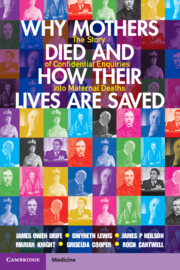 Why Mothers Died and How their Lives are Saved
Why Mothers Died and How their Lives are Saved Published online by Cambridge University Press: 05 April 2023
In the eighteenth century medical schools and hospitals first appeared in Britain, and so did man-midwives. One of them, William Smellie, was later called 'the father of British midwifery'. In the nineteenth century the medical profession became organised, anaesthesia was discovered and the germ theory of infection was proved. The Obstetrical Society of London was formed in 1858. Midwives, however, were seen as incompetent 'Sarah Gamps'. This changed in 1902 when the Midwives Act transformed midwifery from a craft into a profession, after a long campaign led by a nurse, Zepherina Smith, and a doctor, Sir Francis Champneys, who became chairman of the Central Midwives Board. In the twentieth century the Ministry of Health was established and maternity homes were created. In 1929 the British College of Obstetrics and Gynaecologists was formed but most births took place at home, where a GP would be called if complications occurred. All this time the maternal mortality rate did not change. From 1830 until 1930 one mother died in every 250 births. What did change was the public mood, and demand for action steadily grew.
To save this book to your Kindle, first ensure [email protected] is added to your Approved Personal Document E-mail List under your Personal Document Settings on the Manage Your Content and Devices page of your Amazon account. Then enter the ‘name’ part of your Kindle email address below. Find out more about saving to your Kindle.
Note you can select to save to either the @free.kindle.com or @kindle.com variations. ‘@free.kindle.com’ emails are free but can only be saved to your device when it is connected to wi-fi. ‘@kindle.com’ emails can be delivered even when you are not connected to wi-fi, but note that service fees apply.
Find out more about the Kindle Personal Document Service.
To save content items to your account, please confirm that you agree to abide by our usage policies. If this is the first time you use this feature, you will be asked to authorise Cambridge Core to connect with your account. Find out more about saving content to Dropbox.
To save content items to your account, please confirm that you agree to abide by our usage policies. If this is the first time you use this feature, you will be asked to authorise Cambridge Core to connect with your account. Find out more about saving content to Google Drive.